Physical Address
304 North Cardinal St.
Dorchester Center, MA 02124
Advances in gene sequencing and genotype-phenotype profiling have furthered understanding of many brain malformations. Some malformations previously considered disparate in terms of gestational timing and etiology are now considered phenotypic variants of common pathways while others previously considered variants of a specific malformation are now known to result from mutations affecting disparate molecular pathways (e.g., the lissencephalies). Given the large number of congenital human brain malformations, the complexity of the molecular genetics, and the degree of anatomic variability, an in-depth discussion of some malformations is beyond the scope of this chapter. This chapter will address malformations seen most often in clinical practice and malformations that, although less common, are distinctive and have a profound impact on early childhood development. The malformations presented herein are grouped according to presumed dominant defect in embryologic or fetal development. Diffusion tensor imaging (DTI) is included for malformations in which aberrant white matter tracts are a dominant feature of the malformation.
A rudimentary description of relevant embryology is needed. Around 26 to 28 days after conception, primary neurulation occurs, in which the lateral edges of the neural plate elevate into neural folds under the control of signaling genes such as sonic hedgehog (SHH) , which is also important in prosencephalic differentiation. The folds then fuse medially to form the neural tube; initial fusion is in the middle of the embryo with subsequent closure of the cranial and caudal ends (neuropores) of the neural tube. The primitive brain vesicles (e.g., the prosencephalon, mesencephalon, and rhombencephalon) form at the cranial end of the neural tube. The prosencephalon divides into the telencephalon, which gives rise to the cerebral hemispheres, lateral ventricles, and corpus striatum, and the diencephalon, which gives rise to the thalami and hypothalamus. The cerebral peduncles and midbrain arise from the mesencephalon while the rhombencephalon gives rise to the metencephalon, which forms the pons and cerebellum, and the myelencephalon from which arises the medulla .
Failure of closure of the cranial neuropore results in anencephaly (e.g., absent forebrain, skull, and scalp), a lethal malformation. Less severe disorders of cranial neuropore closure result in meningoceles and encephaloceles, which are protrusions of meninges or brain respectively through a congenital defect of the skull and dura occurring in about 1/5000 live births. Encephaloceles in Asian children tend to be anterior, whereas those in occidental children tend to be posterior and both are most often midline. Frontal encephaloceles include interorbital frontal, nasofrontal, nasoethmoidal, and nasoorbital lesions. Interorbital frontal encephaloceles protrude through a defect in the frontal bone ( Fig. 31.1 ). Nasofrontal encephaloceles involve the region of nasal bridge and/or the floor of the anterior cranial fossa ( e-Fig. 31.2 ). Nasofrontal encephaloceles are also referred to as nasal gliomas , although they are not neoplastic. These masses of neuroglial tissue are categorized as extranasal (60%), intranasal (30%), or mixed (10%). When there are telangiectasias on the skin overlaying an external nasal glioma, the lesion may be mistaken for a hemangioma. There is often hypertelorism with a broad nasal bridge. Intranasal glioma present as an intranasal mass; biopsy should be avoided before imaging due to the risk of meningitis. With nasoethmoidal encephaloceles, the frontal bone is intact. The neural tissue bulges into the ethmoid sinus through a defect in the floor of the anterior cranial fossa, and the nasal septum defines the posterior margin of the encephalocele. A defect in the medial orbital wall results in a nasoorbital encephalocele, which protrudes into the orbit with unilateral exophthalmos. Other facial anomalies seen with anterior encephaloceles include a bifid nasal tip or complete midline splitting of the nose in an uncommon malformation known as frontonasal dysplasia . Basal encephaloceles result from defects in the sphenoid bone ( Fig. 31.3 ); the encephalocele herniates into the posterior nasopharynx anterior to the dorsum sella and may contain pituitary tissue, optic nerves, and/or branches of the circle of Willis. Parietal encephaloceles range from large, deforming, “towering” lesions to small meningoceles ( e-Fig. 31.4 ). Atretic parietal encephaloceles or meningoceles present as a small vertex subcutaneous fibrofatty masses, often painful to palpation ( e-Fig. 31.5 ). Occipital encephaloceles may contain dysplastic cerebellar tissue alone or with cerebral cortex ( Fig. 31.6 ). Rarely, the brainstem may be within the encephalocele making this malformation lethal. The prognosis depends on the severity of associated brain anomalies and the amount of dysplastic brain contained within the encephalocele. Although dysplastic nonfunctional neural tissue is usually resected during encephalocele closure, major dural venous sinuses are preserved if possible. Hydrocephalus is common after closure of large parietal and occipital encephaloceles.
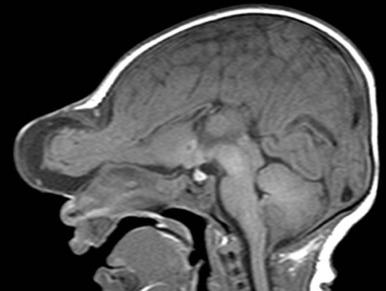
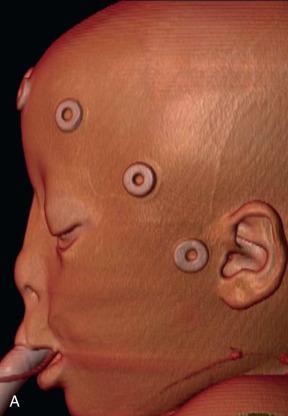
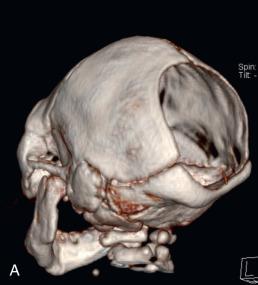
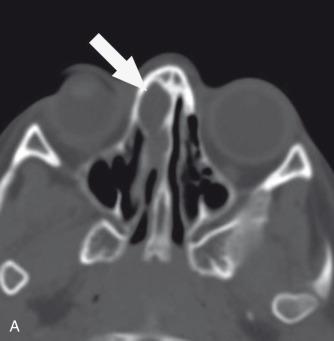
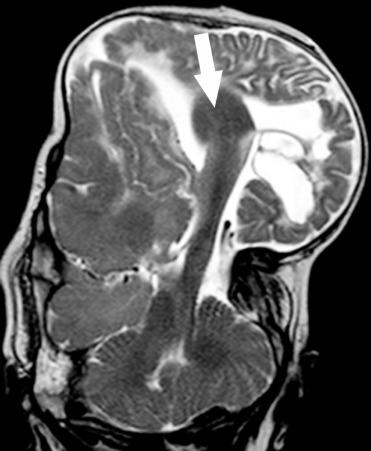
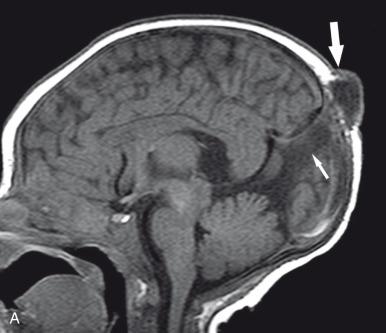
Occipital encephaloceles are seen in trisomy 13 and 18, amniotic band syndrome, Meckel-Gruber syndrome, dyssegmental dwarfism, Knobloch syndrome, Walker-Warburg (Type II lissencephaly) syndrome, cryptophthalmos, and Voss syndrome. Frontal encephaloceles are seen in morning glory syndrome includes midline facial defects, callosal agenesis, and characteristic eye anomalies.
High-resolution magnetic resonance imaging (MRI) is performed soon after birth to define contents of the encephalocele and the severity of associated brain anomalies, which include callosal agenesis, malformations of cortical formation, and variable anomalies of the cerebellum, diencephalon, and brainstem. Magnetic resonance (MR) venography is essential with large occipital and midline parietal encephaloceles that may contain dural venous sinuses. Atretic parietal encephaloceles are characterized by posterior tenting of the tectal plate, a persistent falcine sinus with hypoplasia or atresia of the straight sinus, and focal expansion of posterior interhemispheric subarachnoid space.
The Chiari II malformation is the intracranial manifestation of failure of closure of the caudal neuropore, which results in failure of the temporary occlusion of the neural tube needed to distend the primary brain vesicles. Failure of distension of the primitive ventricular system results in premature fusion of the mesenchymal components that form the calvarium while the hindbrain manifestations result from leakage of cerebrospinal fluid (CSF) through the neural tube defect.
Neural tube defects have been reported with multiple chromosomal abnormalities, including trisomies 18, 13, and 9, triploidies, unbalanced translocations and deletions, and in syndromes such as Turner, DiGeorge, and velocardiofacial syndrome. The genes in the region of 22q11 have been implicated in the development of neural tube defects, although neural tube defects and the associated Chiari II malformation are probably due to a combination of genetic polymorphisms and environmental factors, including dietary folate intake and maternal folate metabolism.
The Chiari II malformation is characterized by mesodermal dysplasia, small and dysplastic lower cranial nerve ganglia, deficient tentorium cerebelli, hypoplastic and dysmorphic cerebellum, and thickened basal meninges. As in holoprosencephaly (HPE), these anomalies are attributable to defective or deficient mesenchyme, which presumably deprived the skull base, hindbrain, and rhombencephalon of normal inductive effects. Clinical problems related specifically to the malformed hindbrain include apnea, aspiration, feeding difficulties, and recurrent respiratory infections. Prenatal closure of myelomeningoceles reportedly decreases the need for ventricular shunting, decreases hindbrain herniation, and marginally improves the level of the motor deficit compared with those patients who undergo postnatal closure of the spinal dysraphic defect.
The calvarial manifestations of the Chiari II malformation include a bifid frontal bone and lückenschädel or lacunar skull. Lückenschädel is due to nonossified fibrous bone in the inner and outer tables of the skull that results in the apparent scalloping of the cranium ( Fig. 31.7 ); the affected cranium ossifies by 6 months of age. Lückenschädel is not the result of increased intracranial pressure and is not synonymous with the beaten copper skull.
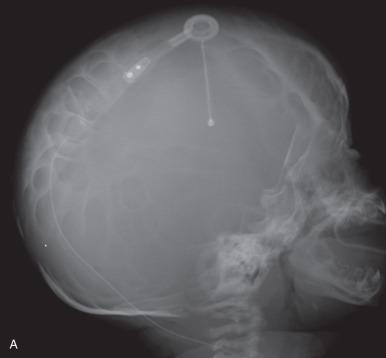
The intracranial stigmata of the Chiari II malformation are typically infratentorial and less pronounced in patients who have undergone prenatal closure of the myelomeningocele. MRI shows caudal displacement of dysplastic brainstem and hypoplastic cerebellum into the upper cervical canal with “kinking” of the cervicomedullary brainstem ( Fig. 31.8 ). The fourth ventricle is effaced and caudally displaced. The torcula and transverse sinuses are low-lying, which presents a potential surgical hazard during decompressive suboccipital craniectomy performed for relief of symptomatic hindbrain compression. There is a “beaked” tectal plate and a variably thickened massa intermedia that may be so thick that the thalami appear virtually fused with partial atresia of the third ventricle. There is an enlarged foramen magnum and constriction of the posterior cranial fossa with effacement of CSF spaces in the posterior cranial fossa; the cerebellum wraps around the ventral aspect of the brainstem, and the clivus and petrous ridges are concave. Common supratentorial abnormities include callosal dysgenesis, neuronal migration anomalies, and hydrocephalus seen in 95% of patients. After CSF diversion, the cerebral hemispheres drop away from the inner table of the skull, allowing the cortex to interdigitate across the midline under the hypoplastic falx while the superior cerebellar vermis projects upward across a widened tentorial incisura. These findings may also be seen after CSF diversion of severe congenital obstructive hydrocephalus. DTI of Chiari II malformations associated with more severe degrees of cerebellar hypoplasia show variable hypoplasia of the dorsal pontocerebellar tracts with preservation of the corticospinal tracts and medial-lateral lemniscus fibers ( Fig. 31.9 ). The cingulum may be anomalous, crossing the midline above the corpus callosum (see Fig. 31.9 ).
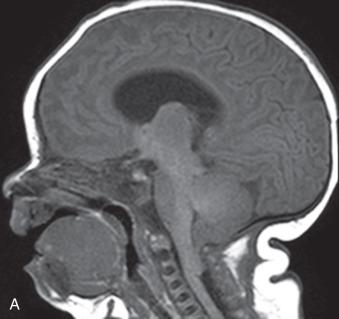
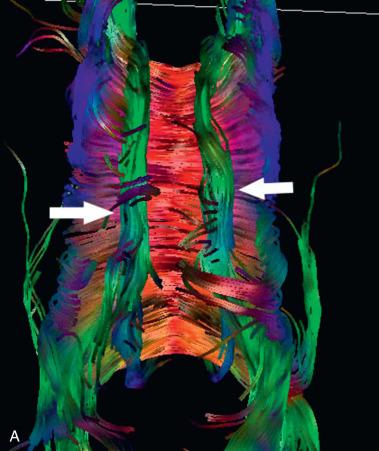
The variants of Chiari malformations (e.g., Chiari III) are seen with high cervical/low occipital encephaloceles with variable cerebellar hypo- or aplasia. Defects of neurulation have been reported to coexist in patients with HPE; the latter malformation is considered a disorder of differentiation of the dorsal neural plate. The coexistence of these malformations traditionally considered disparate in embryologic timing and insult may explained in part by mutations in genes implicated in both neural tube defects and HPE.
HPE is the most common anomaly of the ventral forebrain, occurring in 1/250 embryos and 1/8300–16,000 live births. HPE results from inductive failure of the median and paramedian structures, which are most pronounced in the ventral forebrain and declines in severity from rostral to caudal and from median to lateral. HPE is due to a combination of genetic polymorphisms and environmental factors; the incidence of HPE is increased 200-fold in maternal diabetes mellitus and in prenatal retinoic acid and fetal alcohol exposure. HPE is notable for its genetic heterogeneity; at least 12 HPE loci are implicated in midline brain development. Although 24% to 45% of affected live-born individuals have chromosomal abnormalities, there are no strong correlations between the type or severity of the holoprosencephalic defect and the specific mutation. Frequent facial anomalies include flattening of the nasal bridge, hypotelorism without metopic synostosis, a single central maxillary incisor, cleft lip/palate to facial clefting, and cyclopia with a central proboscis. More severe facial anomalies are seen with more severe variants of HPE, whereas mild facial anomalies may occur in the absence of brain anomalies. Clinical problems include developmental delay, seizures, hypothalamic and brainstem dysfunction with swallowing problems, thermal instability and respiratory problems, pituitary dysfunction, and erratic sleeping.
There is considerable topographic variation in HPE, which is most often characterized as alobar, semilobar, or lobar. The hallmark of HPE is incomplete separation of the forebrain, variable hypoplasia of the frontal lobes, absence of the anterior interhemispheric falx, and variable fusion of central grey nuclei with absent septum pellucidum.
In this most severe form of HPE, there is complete lack of separation between the cerebral hemispheres with absence of the falx. The corpus callosum and septum pellucidum are absent, the central grey nuclei are fused, and the rudimentary single ventricle has a “ U ” configuration that may communicate with a dorsal cyst ( Fig. 31.10A ).
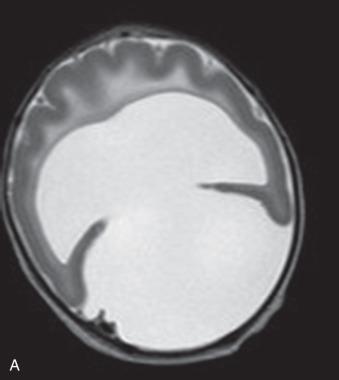
There is relative preservation of the lateral and posterior cerebrum and the splenium ( Fig. 31.10B-D ). The posterior interhemispheric fissure and falx are present while the hypoplastic frontal lobe is undivided. Frontal lobe hypoplasia results in the anterior position of the Sylvian fissures, termed a wide Sylvian angle . The globus pallidi are absent or hypoplastic, and the caudate nuclei are fused, resulting in obliteration of or lack of formation of the septal region. The posterior limbs of the internal capsules are ventral to partially or totally fused thalami. The hippocampus is virtually always present, although usually incompletely or abnormally developed. There may be a dorsal cyst. DTI shows fornices imbedded in dysplastic thalami and bands of anomalous white matter crossing the forebrain.
In this mildest form of HPE, there is hypoplasia of the frontal poles, agenesis of the septal pellucidum, and incomplete separation of the basal forebrain, which is best depicted with high resolution coronal images ( Fig. 31.11 ). The posterior frontal, parietal, and occipital lobes are more normally formed. The callosal body and splenium are preserved.
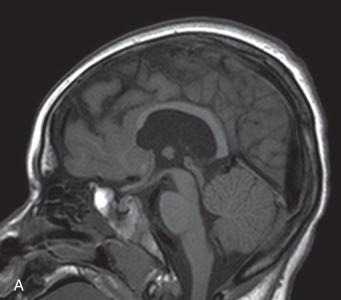
The middle frontal variant is an unusual variant of lobar HPE characterized by separation of the frontal and occipital poles, fusion of the middle portions of the cerebral hemispheres ( Fig. 31.12 ), preservation of portions of the commissural fibers of the corpus callosum, and neuronal migration anomalies; thalamic fusion is variable.
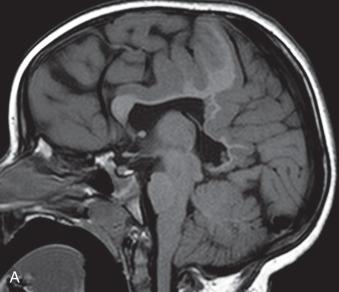
Septo-optic dysplasia (SOD) is considered along the continuum of disorders of ventral forebrain differentiation. Patients typically present in early childhood with nystagmus, optic nerve atrophy, short stature due to growth hormone deficiency, or panhypopituitarism with or without diabetes insipidus. Affected patients are at risk for Addisonian crisis due to subclinical adrenal insufficiency, which may become clinically apparent only during illness or severe stress. Most cases of isolated SOD are sporadic.
SOD is characterized by absence of the septum pellucidum and variable optic nerve hypoplasia ( Fig. 31.13 ). The neurohypophysis may be ectopic and the pituitary stalk may be interrupted. However, agenesis of the septum pellucidum may be isolated with normal optic pathways and intact neuroendocrine function. Absence of the septal leaves results in downward displacement of the fornices into the third ventricle. SOD is seen in multiple malformations such as schizencephaly, neuronal migration anomalies, and neural tube defects.
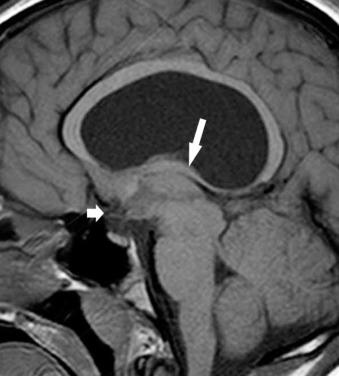
Agenesis of the corpus callosum (ACC), one of the most common central nervous system (CNS) malformations (0.5–70/10,000 live births), is genetically and phenotypically heterogeneous with clinical phenotype dependent on coexistent malformations and numerous chromosomal abnormalities and syndromes. Affected patients have variable developmental delay, including speech, problems with vision and feeding, and seizures.
Formation of the corpus callosum begins around 6 weeks' gestation, with initial axonal crossing around 11 to 12 weeks' gestation, and completion of callosal formation around 18 to 20 weeks. The first axons to cross the midline arise from neurons destined for the cingulate cortex and provide a path for subsequent migrating callosal axons arising elsewhere in the developing neocortex. The crossing axons are controlled by the glial wedge composed of radial glial cells that geographically limits the passage of axons and then repel the axons away from the midline by expressing molecular guidance cues. Other embryonic structures important in callosal formation include the indusium griseum above the callosal body and the subcallosal sling. After crossing the midline, callosal axons grow into the contralateral hemisphere; their ultimate destination mirrors their region of origin and the cortical layer of the parent neuron. Many of the crossing callosal axons undergo programmed cell death after reaching their final destination, which starts during the second trimester with postnatal pruning of axonal axons. When the axons fail to cross the midline and remain in their hemisphere of origin, the misrouted callosal axons may course along the medial aspect of the lateral ventricle forming the longitudinal callosal bundles of Probst. Alternately, aberrant axons may project to the contralateral hemisphere across a rudimentary callosal genu as nonhomotopic fibers. Patients with isolated ACC and well-developed Probst bundles may be developmentally intact and processing deficits detected only with neurocognitive assessment.
The anterior commissure (AC) is a variably sized tract embedded in the cranial aspect of the lamina terminalis, which demarcates the anterior wall of the third ventricle and may be enlarged, normal, or small in ACC. The hippocampal commissure is a thin sheet of white matter connecting the fornices, which is not routinely visualized on MRI of the normal brain. Absence of the corpus callosum, AC, and hippocampal commissure is described as “complete commissural agenesis” ( Fig. 31.14 ). Preservation of the AC in the absence of the corpus callosum and hippocampal commissure is “calloso-hippocampal agenesis,” whereas the anterior and hippocampal commissures may be preserved, resulting in “isolated callosal agenesis.” Calloso-hippocampal agenesis is the most common malformation, although it might be argued these classifications are somewhat academic. By MRI, the sulci over the mesial surface of the frontal lobes have a radial configuration and the lateral ventricles have a characteristic parallel orientation. Absence of the temporal segments of the cingulum results in dilatation of the temporal horns while hypoplasia of association fibers connecting the occipital and temporal lobe allows dilatation of trigones of the lateral ventricles, referred to as colpocephaly . Callosal agenesis may be associated with interhemispheric diencephalic pseudocyst (e.g. high-riding third ventricle) or interhemispheric cysts that do not communicate with the ventricles. In patients with a rudimentary callosal genu, diffusion tractography shows the nonhomotopic aberrant callosal connections described as “asymmetric sigmoid bundles” and have also been reported in patients with aberrantly shaped corpus callosum.
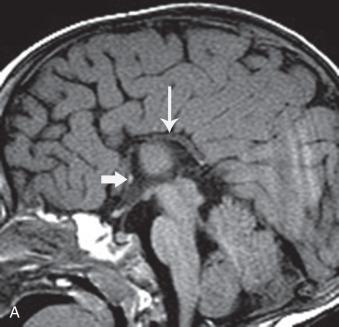
Callosal agenesis may be isolated or associated with aqueductal stenosis, Chiari II malformations, and malformations of cortical development (MCD), brainstem, and cerebellum. There are numerous syndromes associated with complete or partial ACC. Aicardi syndrome is a rare sporadic X-linked dominant malformation seen in females characterized by callosal agenesis, interhemispheric neuroepithelial cysts, and MCD ( Fig. 31.15 ); affected males have Klinefelter syndrome (47,XXY). Ocular abnormalities include chorioretinal lacunae and coloboma; the cerebellum may be malformed. CRASH syndrome (corpus callosum agenesis, retardation, adducted thumbs, spastic paraplegia, and hydrocephalus) is caused by mutations in the L1 cell adhesion molecule gene that codes for a transmembrane cell adhesion protein involved in axonal migration.
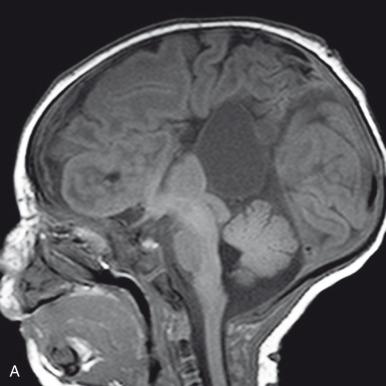
The corpus callosum may be incompletely formed, diffusely hypoplastic, or segmentally deficient ( e-Fig. 31.16 ). Partial callosal agenesis is usually characterized by absence of the splenium and dorsal body with relative preservation of the genu and rostral body, although the reverse may be seen. Diffuse callosal hypoplasia is characterized by diffuse thinning, while segmental callosal hypoplasia involves an intermediate portion of the corpus callosum. The segmental defects may result from a secondary callosal destruction or injury to regional white matter. Callosal hyperplasia may be diffuse, as seen in neurofibromatosis type 1, or limited to the midcallosal body, in which case the corpus callosal is often foreshortened. DTI of the congenitally thickened corpus callosum often shows anomalous longitudinal supracallosal fibers that represent misrouted callosal axons.
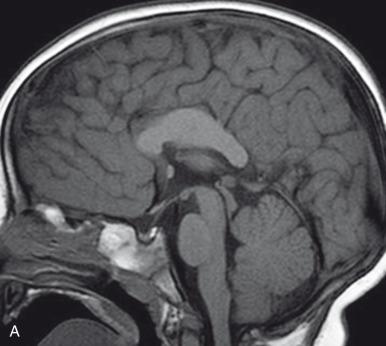
Callosal lipomas are rare and are thought to result from abnormal differentiation of pluri-potential mesenchymal tissue. Most of cases are associated with agenesis or incomplete formation of the corpus callosum. Anterior lipomas are more common than posterior. The lipoma itself is an incidental finding and may be seen with a fully formed corpus callosum.
There are more than 400 phenotypes associated with microcephaly, discussion of which is beyond the scope of this chapter. Primary nonsyndromic microcephaly is autosomal recessive and genetically diverse. Genes implicated in primary microcephaly affect the centrosomes, centrioles, and spindle fibers of neuronal precursors adversely affecting neuronal proliferation and migration; the net result is diffuse thinning of the cerebral cortex. Seizure disorders are uncommon; 15% of patients have normal neurodevelopmental outcomes.
MR may show a small, otherwise normal brain or diffuse undersulcation. DTI may show unsuspected anomalous white matter tracts, suggesting axonal migration defects in addition to defective neuronal proliferation and migration.
Brain overgrowth may be diffuse or focal. Diffuse megalencephaly may be isolated or associated with polymicrogyria (PMG) and ventriculomegaly. Megalencephaly is associated with gene mutations affecting protein products in the mammalian target of Rapamycin (mTOR) pathways, which regulate cell metabolism, growth, proliferation, and survival and are implicated in tuberous sclerosis and refractory epilepsy. Hemimegalencephaly reflects focal megalencephaly with somatic mutations affecting only the dysmorphic overgrown tissues. Hemimegalencephaly may be isolated or associated with neurocutaneous syndromes such as epidermal nevus syndrome, Proteus syndrome, unilateral hypomelanosis of Ito, neurofibromatosis type I, Klippel-Trenaunay syndrome, and tuberous sclerosis. Hemispherectomy may be required for relief of severe intractable epilepsy.
Become a Clinical Tree membership for Full access and enjoy Unlimited articles
If you are a member. Log in here